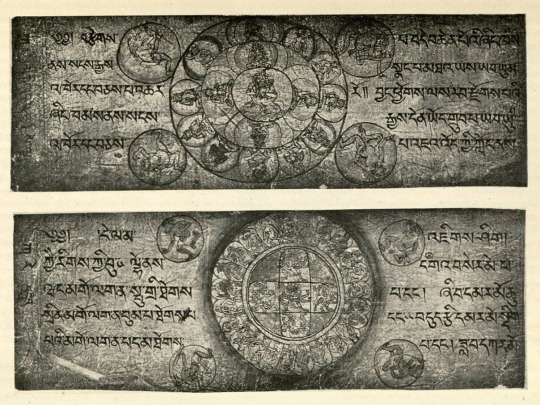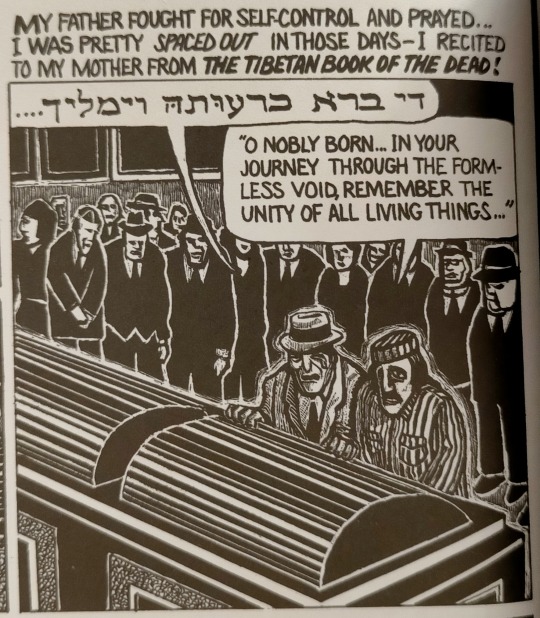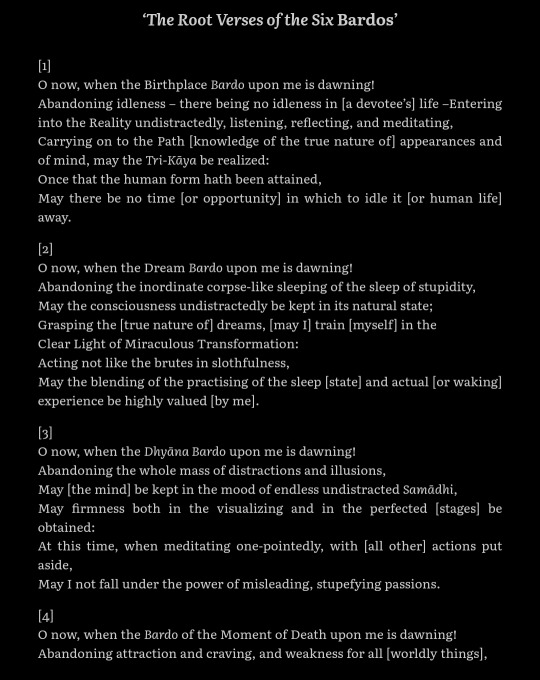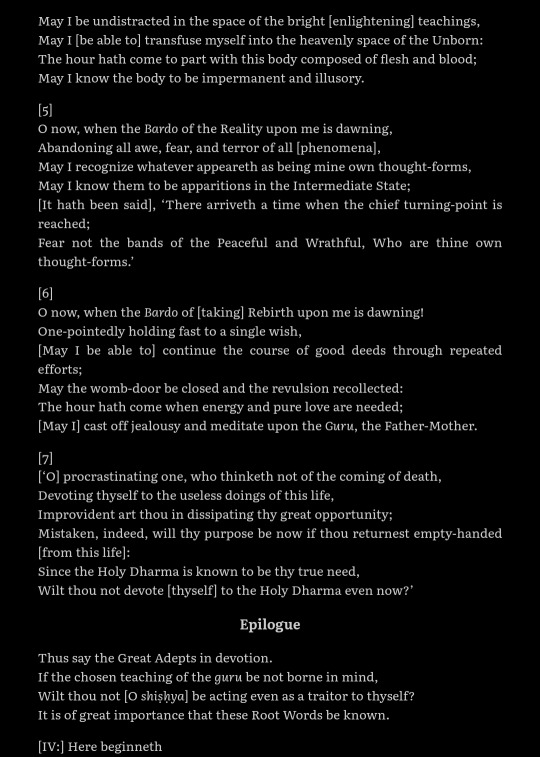#Tibetan book of the dead
Explore tagged Tumblr posts
Text

Pages from the Tibetan Book of the Dead.
#book of the dead#tibetan book of the dead#bardo thodol#karma lingpa#tibetan#tibetan alphabet#tibetan script#content
75 notes
·
View notes
Quote
With mind distracted, never thinking, "Death is coming,"To slave away on the pointless business of mundane life,And then to come out empty--it is a tragic error. (116)trans by Robert Thurman
Huston Smith, Tibetan Book of the Dead
3 notes
·
View notes
Text
Tibetan Book of the Dead: what you need to know

The Tibetan Book of the Dead, known in Tibetan as Bardo Thödol (meaning "Liberation Through Hearing During the Intermediate State"), serves as a crucial guide in Tibetan Buddhism for navigating the experiences of death and the afterlife. It is structured around the concept of bardo, which refers to the intermediate states between death and rebirth.
Purpose The primary aim of the text is to assist the consciousness of the deceased during the 49 days following death, helping it navigate through various stages of existence and achieve liberation from the cycle of rebirth (samsara). It emphasizes that death is not an end but a transition, where understanding and recognition can lead to a favorable rebirth or enlightenment.
Historical Context Attributed to Padmasambhava, an 8th-century Indian master, the text was likely composed in the 14th century by Karma Lingpa . It was initially hidden due to its profound teachings and rediscovered centuries later, reflecting its significance in Tibetan culture. The first English translation was done by Walter Evans-Wentz in 1927, bringing it to a wider audience.
Structure
The Bardo Thödol outlines three main bardos:
Chikhai Bardo: The moment of death, where one encounters the "clear light" of reality. This stage offers an opportunity for liberation if recognized .
Chonyid Bardo: The experience of various visions and deities, which can be frightening. Recognizing these as illusions is crucial for navigating this phase successfully.
Sidpa Bardo: The stage leading to rebirth, characterized by karmically influenced hallucinations that determine one's next existence based on past actions .
Key Concepts
Karma: Actions in life influence future rebirths; good deeds can lead to favorable outcomes while negative actions may result in suffering .
Liberation: Attaining enlightenment (moksha) is the ultimate goal, freeing one from the cycle of birth and death .
Recitation: The text is meant to be read aloud by monks (lamas) to the deceased, offering guidance and comfort during their journey through the bardos .
Conclusion The Tibetan Book of the Dead remains a vital spiritual resource, addressing existential questions about life, death, and rebirth while providing practical instructions for both the living and the deceased. Its teachings emphasize awareness and understanding as keys to navigating life's transitions effectively.
3 notes
·
View notes
Text
Are you enslaved to the sisyphean effort to escape yourself?
Are you ready to be here now?
You may fear the bonds of your own will,
But at its root is your deepest desire,
And this is your reason to be alive.
In truth, many of us are so afraid
Of just how vital this is to us
The freedom to fulfill this impulse
Is the most important thing,
If we were to open it, and it be denied
The result would be worse than death
So in attempting to avoid the determinism
Which comes with committing to oneself,
We are enslaved by fear,
Endless effort to escape our own hearts,
With nowhere to hide
Our will crumbles,
And our deepest desires
Are hidden among the rubble
Of our broken parts
But it is not too late now,
For it is the darkest hour
Which heralds the discovery
Of the secret of light
Be not afraid now,
For all else is spent,
And it is time to know yourself again,
Enter into your heart
With submission,
Innocently surrender
And you will remember who you are
6 notes
·
View notes
Text

Meridian Brothers - Mandala
#mandala#meridian brothers#cocaine#Nose candy#sand mandala#tibetan#tibetan buddhism#sangha#dharma#mahayana#zen#blasphemy#monks#tibetan monk#dalai lama#buddha#tibetan art#tibetan culture#tibetan book of the dead#sanskrit#snorting#jokes
6 notes
·
View notes
Video
youtube
What is the Tibetan Book of the Dead?
2 notes
·
View notes
Text
The Transformative Power of Grieving: Finding Healing Through Storytelling and Presence in the Bardo’s
Twitter Patreon GitHub LinkedIn YouTube Preamble: Confessions I lost my papa recently. And while I never sometimes my father, it was Papa who failed in presence, support, and generosity. Merten Wolfe changed his name to Martin Rankin upon immigrating from a postwar Germany, when America was pregnant with late stage capitalism and MTV still played music videos. We come from a clan of Romani…

View On WordPress
#bardo#bardos#book of the dead#buddha#buddhism#buddhist#grief#living and dying#loss#Poem#Poetry#psychology#taoism#taoist#Tibetan#Tibetan book of the dead#Tibetans
2 notes
·
View notes
Text
youtube
The Forbidden Book About Death They Don’t Want You to Read....no bs
What lies beyond the veil of death? The Tibetan Book of the Dead holds profound answers, offering timeless teachings for navigating life’s transitions and preparing for the ultimate journey after death. In this video, we’ll explore the Bardos—the intermediate states between life, death, and rebirth—and uncover their lessons for liberation and spiritual awakening.
This isn’t just a guide for the dying—it’s a manual for the living. Whether you’re seeking peace in the face of uncertainty or wisdom to transform your daily life, this video reveals insights that could change everything.
0 notes
Text
El libro tibetano de los muertos

Apuntes sobre la lectura. (Me quedé apenas en la página 7)


El primer Bardo, llamado Chikhai o Estado Transitorio del Momento de la Muerte es el que ocurre inmediatamente después del deceso, cuya duración es entre 3 días y medio y cuatro. En este estado aparece la Clara Luminosidad, primero como pureza primordial, aunque posteriormente el que percibe (el muerto), incapaz de reconocerla, es decir, incapaz de aferrarse y de permanecer en ese estado debido a su karma de mente no modificada, la percibe como oscurecida.
Cuando este Bardo finaliza, el difunto despierta al hecho de la muerte; se hace, por lo tanto, consciente de su cambio de estado, y empieza a experimentar el segundo Bardo, denominado Chonyid o Estado Transitorio de la Realidad, momento de la confrontación con las Divinidades Apacibles y las Divinidades Irritadas (desde el octavo al décimo cuarto día).
El difunto se encuentra bajo la ilusión (a menos que sea un iniciado y que haya despertado la conciencia ante los diferentes cambios de estado y sea, en consecuencia, capaz de discernir) de que aunque está muerto, todavía posee un cuerpo de carne, huesos y sangre y, además, se le aparecen visiones simbólicas creadas por sus propios reflejos kármicos motivadas por las acciones y pensamientos que creó cuando se hallaba en su estado de conciencia física que pertenece a la personalidad. En el momento en que el difunto se percata de que en realidad no posee un cuerpo físico real empieza a desarrollar un descollante deseo de poseer uno y, al hacerlo, entra inmediatamente en el tercer Bardo, denominado Sidpa o Estado Transitorio del Renacimiento, que finaliza cuando el principio de la conciencia renace en el mundo humano o en algún otro de los diversos mundos de renacimiento.

0 notes
Text
This was really good, thank you!
Two Otherworldly Books: Polar Opposites?
Two Otherworldly Books: Polar Opposites?
The two most famous mystical manuals for guidance through the Otherworld are, in staggering ways, diametric opposites. The Tibetan Book of the Dead was preserved by the living, its chapters kept intact over millennia by monks in monasteries. Contrariwise, the Egyptian Book of the Dead was preserved by mummies, its chapters scattered piecemeal (even as Osiris was dismembered?) and sealed for millennia in coffins and tombs. The Tibetan was meant to be recited to a corpse by a living undertaker. The Egyptian was meant to be read only by the deceased individual, in the afterlife. In the Tibetan, the soul navigating the afterlife liminality is a human who encounters deities and torments, judgments, and pitfalls, the book serving as a guide map to another incarnation. In the Egyptian, the soul in the netherworld is itself a divinity (indistinguishable from all deities), the book constituting “identity papers” that exempt one from any torments, judgments, or pitfalls on the way not to another incarnation but rather eternal providence. The Tibetan is read in whole and then retained by the living. The Egyptian is unread in fragments (as chapter 64 notes, “This composition is a secret; not to be seen or looked at … by any man, for it is forbidden to know it. Let it be hidden”) and retained by the dead. The Tibetan would have the soul disattach from memories of illusory experiences. The Egyptian soul, as a deity having been disguised as a mortal, is prompted to say, “That which I went in order to ascertain I am come to tell. Come let me enter and report my mission” (chapter 86). The Tibetan calls the soul toward realms indescribable by known language, while the Egyptian promises a perpetuity of familiar worldly food, bodily pleasures, landscapes, climates, planting and reaping, labor and recreation. Clerical (pun intended) errors by Egyptian scribes corrupted the book to the extent that varied copies of the same chapter are wildly discordant. It would seem that over the millennia the copyists did not understand the original texts, the original meanings having been lost at a very early date. The Tibetan, while similarly reproduced, is significantly less adulterated. Because the Egyptian copies were never meant for living eyes, the scribes’ attention to detail naturally faltered (in other words, the accuracy of their work went unchecked). It was the opposite situation for the Tibetan scribes. As the Egyptian is significantly bastardized, translators are so often left to conjecture, to either fill or not fill the empty pools of textual lacunae, to baffle over the legitimacy of enigmatic hapax legomena. Yet there’s a strange poetry to that — a book of metaphysical mysteries, not meant for living eyes, gathering further unfathomableness over time. (Somewhat ironically, Egyptologists seek “accuracy” of non-literal, possibly deliberately nonsensical esoterica and paronomasia. As translator Peter Le Page Renouf notes, the various chapters of the Egyptian Book of the Dead and other texts prove that “with reference to the details, free scope was allowed to the imagination of the scribes or artists.” Though Renouf fastidiously checked his own guesswork, he perhaps needn’t have been overly cautious. The Egyptian Book of Dead would seem to be unstuck in time and even unstuck in phraseology, like a text in an hallucinatory dream that morphs as the visionary tries to read it.) In short, the Tibetan (guarded at extraordinarily high elevations) is addressed to human beings, while the Egyptian (preserved at very low elevations) is addressed to gods. P.S. Interestingly, the judgment scenes in both books are so alike in essentials as to suggest a common prehistoric origin. The Tibetan’s King of the Dead as judge corresponds to the Egyptian Osiris. Both books have a symbolical weighing. On the scales before the King of the Dead, black pebbles are weighed against white (symbolizing evil and good deeds). Before Osiris, the heart and a feather are weighed (conduct/conscience against righteousness/truth). In both books, a simian-headed figure oversees the weighing (the ape-headed Thoth in the Egyptian, the monkey-headed Shinje in the Tibetan). In both books, a jury of deities looks on, some animal- and some human-headed. The record-board that Thot holds corresponds to the Mirror of Karma held by the King of the Dead. The deceased in both books pleads innocence. See Books of the Dead, a distillation of twenty-four books of the dead from around the world and across the centuries. Each book’s most intriguing, poetic, and useful revelations are painstakingly gathered.
Wondering about this post? Wait for the dissertation (TBA). For now: Weblog ◆ Books ◆ Videos ◆ Music ◆ Etsy
#afterlife#book of the dead#egyptian#egyptian book of the dead#esoteric#life after death#tibetan#tibetan book of the dead
58 notes
·
View notes
Text

"The Complete Maus" - Art Spiegelman
#book quote#maus#art spiegelman#nonfiction#prisoner on the hell planet#father#family#death#fighting#self control#praying#spaced out#tibetan book of the dead#funeral
1 note
·
View note
Text

Have you been to Ray's Occult Bookstore in Greenwich Village?
#ghostbusters#ray stantz#occult#occult bookstore#nyc#greenwich village#movies#tibetan book of the dead
0 notes
Text
How To Die- Instructions from the Tibetan Buddhist Tradition
Today is my birthday, the inception of a dangerous, insonsolable and heart wrenching war in the Middle East. It is a particulary poignant fall day as one of my very close friends is dying. He is called a Vajra Brother, and we have many of the same teachers and he sent this to me as a guide as to how to help him. I thought I would offer it to you all, as indeed, we all will pass, and there are…

View On WordPress
#and Karmic Becoming#How To Die- Instructions from the Tibetan Buddhist Tradition#Luminous Dharmata#mind#Tibetan Book of the Dead#Training Guide to the Bardos of Dying
0 notes
Text
life between lives: case study 1
♡︎ soul sees dead body in hospital, doesn't feel dead, sees grieving family
♡︎ influenze pandemic
♡︎ younger soul
♡︎ memories in the super-conscious
♡︎ 1866, great pain, throat, choking
♡︎ soul's can leave their human hosts minutes before death
♡︎ sensations at time of death - a force of some kind pushing soul out of the dead of the body - 'me' comes out. 'I' come out
♡︎ radiate light, light energy, transparent white soul, energy light grows a little as it moves around
♡︎ the light expands, whispy
♡︎ shed my skin
♡︎ lose my body in one swoosh
♡︎ freeing, wonderful feeling
0 notes
Text
they have a booktok section in the feltrinelli store what if we all killed ourselves. what if our collective christmas gift for each other was just to pick a time that’s convenient for everybody and then make our brains explode
158 notes
·
View notes

